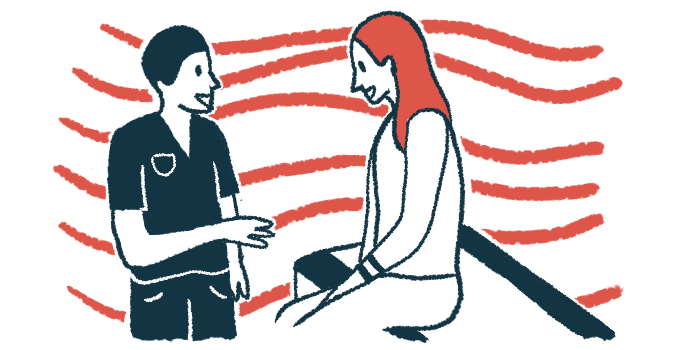MDA 2023: Better effects found with Ultomiris within 2 years of diagnosis
But treatment seen to ease gMG symptoms despite disease length
Written by |

The use of Ultomiris (ravulizumab) led to stronger reductions in generalized myasthenia gravis (gMG) symptoms for people who had been living with the disease for no more than two years, new analyses from the CHAMPION MG trial indicated.
“Overall, our analysis suggests that treatment of gMG with [Ultomiris] earlier in the course of the disease may result in greater benefits in patients,” the researchers wrote.
Still, the treatment led to significant symptom easing among gMG patients regardless of disease length, the team noted.
In another trial analyses, Ultomiris was found to reduce symptoms across specific muscle domains, with the strongest effects on ocular, or eye-related, symptoms.
These findings were presented across two posters at the Muscular Dystrophy Association’s MDA Clinical & Scientific Conference, held March 19-22 in Dallas and virtually.
Analyzing the impact of Ultomiris post-trial
The Alexion-sponsored Phase 3 CHAMPION MG trial (NCT03920293) evaluated Ultomiris against a placebo in 175 adults with gMG who were positive for antibodies against the acetylcholine receptor (AChR) — the most common type of MG-causing antibody.
The therapy, developed by Alexion, now a part of AstraZeneca, has since been approved for adults with gMG who are AChR-positive in several countries. In the U.S., up to about 80% of adults with gMG may be eligible for the treatment. It is delivered directly into the bloodstream every eight weeks, after an initial loading dose, for around six months.
Results from CHAMPION MG showed that Ultomiris was superior to a placebo in improving scores on the the MG Activities of Daily Living (MG-ADL) and Quantitative MG (QMG) scales, reflecting overall reductions in symptom severity.
In the new presentations, scientists discussed findings from post-hoc trial analyses to look at outcomes for certain patient subgroups. Post-hoc analyses are those carried out after the trial has concluded.
The first poster, “Efficacy of ravulizumab in generalized myasthenia gravis according to time from diagnosis: A post hoc subgroup analysis of the CHAMPION MG study,” explored patients’ responses to treatment according to how long they had been living with gMG.
The trial’s participants were split into two groups based on whether they had been diagnosed within two years, or more than two years from the trial’s start.
In all, 35 participants — 19 treated with Ultomiris and 16 with the placebo — had been diagnosed within two years before entering into the trial. The remaining 140 patients, comprised of 67 treated with Ultomiris and 73 with the placebo, were diagnosed more than two years earlier.
Participants who had a longer disease duration were more often female than their counterparts with a shorter disease term (55.7% vs. 31.4%). They also were younger at the time of diagnosis (mean of 42.6 vs. 60.0 years) and when they received their first Ultomiris infusion (mean of 54.3 vs. 60.9 years). MG-ADL and QMG scores were similar between the groups before starting treatment.
In either subgroup, patients given Ultomiris experienced significant improvements in MG-ADL scores compared with the placebo group after six months.
Yet, patients in the shorter disease duration group saw a 2.9-point greater improvement in MG-ADL scores after Ultomiris treatment compared with their respective placebo group, whereas those in the longer disease duration group saw a smaller 1.4-point difference from the placebo group.
Moreover, patients living with gMG for two years or less had numerically greater MG-ADL score reductions (improvements) after six months compared with those living with the disease for more than two years (4.3 vs. 2.9 reduction in points).
Overall, our analysis suggests that treatment of gMG with [Ultomiris] earlier in the course of the disease may result in greater benefits in patients.
In general, the magnitude of clinical improvement was greater the earlier treatment was started, though the researchers noted that additional studies are needed to confirm these findings.
There were no clinically meaningful safety differences between the two groups.
Focusing on the impact of Ultomiris on muscle groups
The second poster, “Ravulizumab in adults with generalized myasthenia gravis: A post-hoc analysis of the phase 3 CHAMPION MG study by muscle domain,” concerned treatment responses across varying subdomains of MG-ADL and QMG scores.
This analysis focused on questions that went beyond the main goal of looking at changes in MG-ADL and QMG total scores to get a broad picture of symptom severity, to instead focus on specific muscle groups.
Each scale in CHAMPION MG contained questions that evaluated weakness in four individual muscle domains: bulbar, limb, ocular, and respiratory. Bulbar refers to the muscles in the head and neck responsible for controlling functions like speaking, swallowing, and chewing.
Researchers here looked at trial participants’ responses across these individual domains.
Ultomiris-treated patients experienced significant improvements in MG-ADL ocular and respiratory domains after six months compared with those in the placebo group. Specifically, patients treated with Ultomiris experienced an 11.5% greater improvement in ocular scores and a 6.1% greater improvement in respiratory scores compared with those given the placebo.
Non-significant trends toward improvement also were observed for bulbar and limb symptoms.
For QMG, Ultomiris was associated with a significant 9.9% greater improvement relative to the placebo in terms of ocular symptoms, and a significant 4.5% improvement for limb symptoms.
No significant differences were observed between Ultomiris and the placebo in respiratory or bulbar domains; respiratory scores tended to worsen in both groups.
Changes observed across the subdomains in either scale were generally rapid and sustained through 26 weeks, or about six months, similar to total MG-ADL and QMG scores.
Data suggest that Ultomiris can lead to “clinical benefits in individual muscle domains affected by gMG,” the researchers wrote, noting that future real-world data collected in an MG patient registry will expand on these findings.








Leave a comment
Fill in the required fields to post. Your email address will not be published.